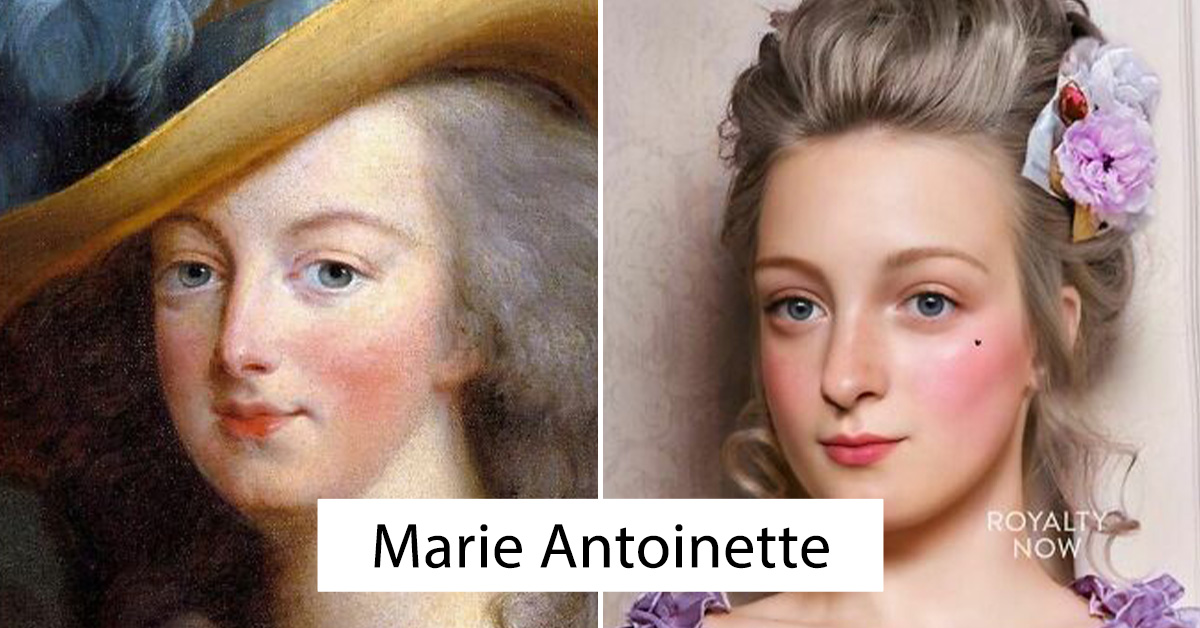Artist Creates Modern Portraits Of Historical Figures (12 Pics)
`Way back in the day, before photographs, humans had to rely on sculptures, paintings, and written descriptions to visualize the appearance of famous historical figures. This made it challenging to be accurate, as people still cannot agree on the true height of Napoleon.
To solve this issue, Becca Saladin, a graphic designer and history enthusiast, decided to create modern portraits of historical figures, and the results are remarkable. Her fascination with history and archaeology since childhood inspired her to start Royalty Now in February 2019 to see how Anne Boleyn would look as a modern woman.
What started as a personal project for Becca became a hit, growing a large following on Instagram with over 300 thousand followers and counting.
Follow Royalty Now: Instagram
Here are some of her coolest modern portraits of historical figures.
1.
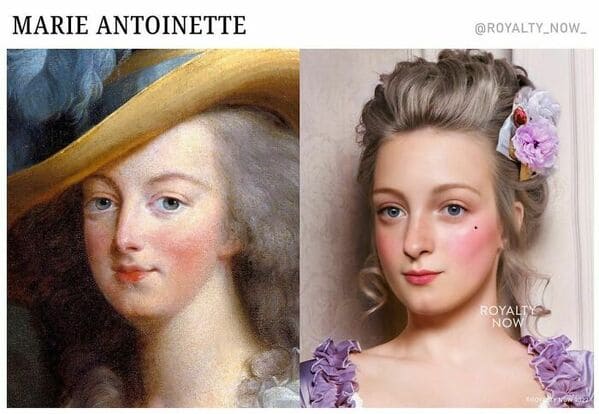
“There is actually a death mask of Marie taken soon after her execution. It was taken by a wax worker whose name you probably recognize: Marie Tussaud. Tussaud got her start during the French Revolution, taking masks of the dead as a sort of real-time commentary on what was going on. Marie was in her late thirties when she was executed, and I’m sure completely worn down by the stress of the revolution. I wanted to combine the features of the death mask with those of the portraits and create a version of Marie Antoinette as Queen in her prime. She still had the same downturned blue eyes, but they look more normal in proportion. Her nose is a bit more hooked in real life than in the portraits, and her lips are flatter, without the pinched, stylized look of the lips in the paintings.”
2.

“A Modern interpretation of Queen Nefertiti from the Berlin Bust.”
3.
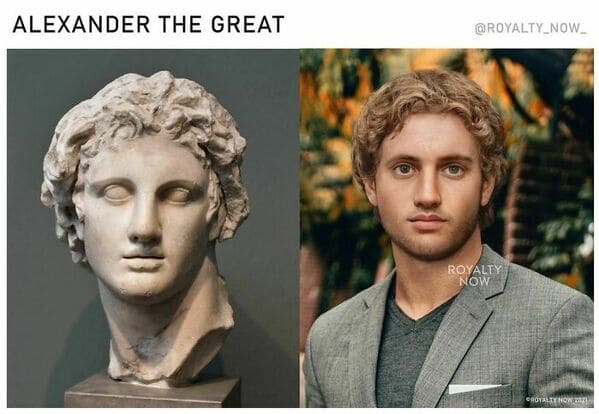
“There are dozens of images of Alexander that can be viewed all around the world, including coinage, busts and full-bodied statues. Despite the wealth of imagery we have today, most are assumed to be later copies of lost originals. It’s clear that depictions of him were idealized in the Greek style.
So what would he look like if he were to appear in front of us today? Firstly, Alexander was what we would now think of as a modern Greek man. He was born in Pella, Macedonia, which is near the top of the modern-day Greek peninsula to parents who were both from Greek kingdoms. Descriptions of him from his lifetime mostly agree that he had blonde or golden hair, fair skin that may have been a bit red, and a handsome face with a prominent forehead. He was also stocky and muscular and may have only been just over five feet tall. An interesting fact about his appearance is that he may have had heterochromia, a condition where the eyes are two different colors or a speckled combination of both. I’ve given him a brown spot in his right eye to reflect this engaging narrative.”
4.
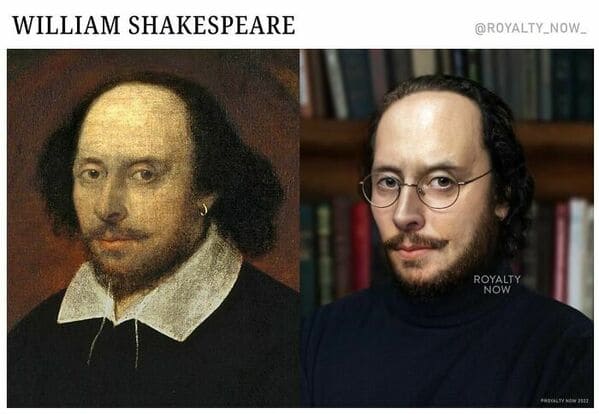
“There is no provenance to this painting, but if it is Shakespeare, it would be the one and only likeness of him taken from life. Here are some reasons why it might be him: The clothing the subject is wearing was popular between 1590 & 1610, the time when Shakespeare was having his greatest successes and therefore most likely to sit for a portrait. The gold earring suggests a “bohemian” appearance – common for a playwright. We can tell the subject is of reasonable wealth because of his all-back clothing. Black dye in large quantities was quite expensive.
I also wanted to share another exciting collaboration between KLEIO and Royalty Now: Introducing A Midsummer Night’s Dream. This candle takes inspiration from its namesake, one of Shakespeare’s most celebrated plays—and recreates the fragrances of a well-known scene.
The thing I find fascinating about this candle is that these are all scents that Shakespeare would have been familiar with in his lifetime. In fact, it may even encourage you to experience Shakespeare’s plays in a new way…and gain a fresh perspective on how he incorporated the senses into his work.”
5.
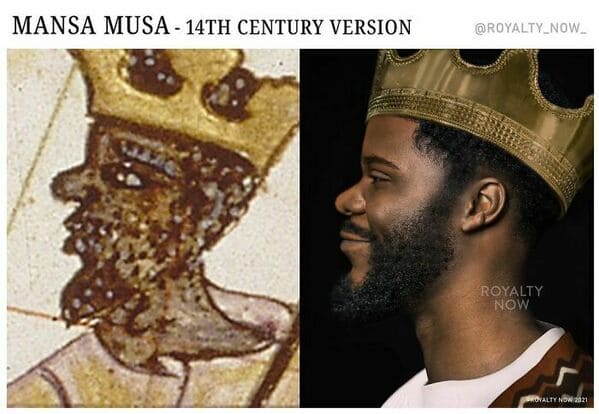
“The richest man that ever lived? This is the refrain that is most associated with Mansa Musa, the Mali ruler from 1312 – 1337. I wanted to make kind of an artistic version of Musa I, for whom unfortunately only this one near-contemporary depiction exists. This image is from the Catalan Atlas, which was illustrated by a Jewish Illuminator, Cresques Abraham, who was unlikely to have seen Musa in person. It shows him in a European-style crown and holding a nugget of gold. He’s such a fascinating figure, I really wanted to represent him somehow, even if it meant taking a lot of artistic liberties. What I’ve done is create a version of him from his own time, and then another of the same man in the modern day.
We do have some loose descriptions of him by contemporaries, which describe him as “A young handsome man.” and “[a] young man, brown-skinned, with a pleasant face and handsome appearance”.”
6.
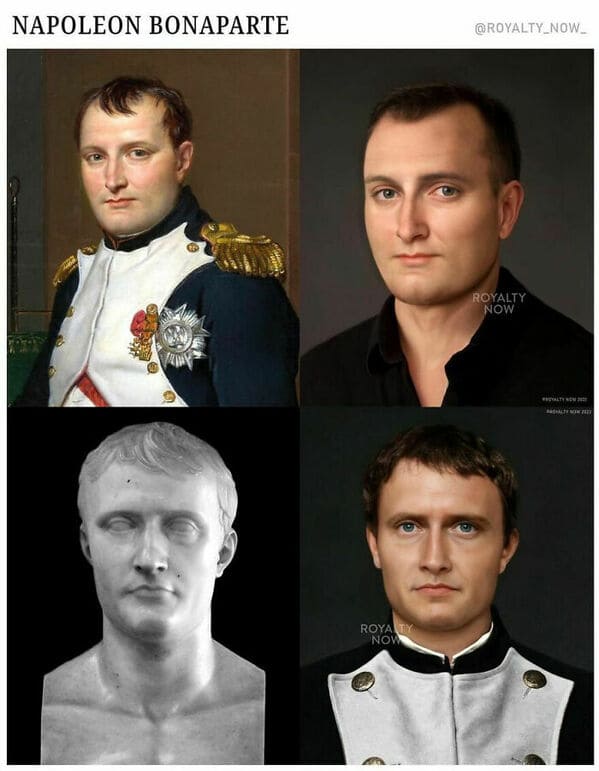
“Shown here by Jacques-Louis David in 1812, Napoleon is the famous French political leader whose military campaigns are still studied today. I had a really old version of Napoleon that I won’t show 😉 but I’m sure some of you have seen it. This is definitely an improvement.”
“There was repeated sentiment from Napoleon’s contemporaries that portraits never seemed to quite capture his true likeness. A friend once wrote that “No one that ever lived had so many likenesses which generally bear some resemblance of feature and form. It was extremely difficult to portray or delineate Napoleon’s look.” We do have a lot of physical descriptions: It was said that he was very thin in his youth, but that he gained weight throughout his life. Others remarked that he had delicate features and piercing grey eyes. And of course, he stood around 5’7”, which was an average height for the time. Napoleon was also a master of propaganda, and he was very careful about which images of himself were released. His main concern was not portraying a true likeness, but portraying his power. For one of my recreations, I’ve used the bust of Napoleon by Antoine-Denis Chaudet. There were over 1,200 copies from the original plaster model that were disseminated throughout the empire as the official likeness of Napoleon. Now of course, he’s depicting himself as essentially a Roman Emperor, and although some said this was the most faithful image of Napoleon, I do suspect that there has been some stylization.”
7.

“Lady Jane Grey is a figure I’ve touched on before, and I made a modern version of her last year. We just recently made a full YouTube video about her life and appearance, check that out at Royalty Now Studios (link in bio), so I created this “in her own time” recreation for that video. I wanted to recreate her also from the Streatham portrait, which is said to be the closest possible link to Jane. It’s still disputed as a true likeness of the Nine-Day Queen but is generally accepted as a somewhat poor copy of a lost original. It dates from around 40 years after Jane’s death and includes a “Lady Jayne” description, as well as clothing that matches Jane’s era.
Lady Jane Grey was 4th in line for the throne when she was born around October of 1537, but I’m sure that she never expected it to come down to her. King Henry VIII and Jane Seymour had just welcomed their son Edward that same month, and they were obviously expecting him to be the future King. Jane was raised as a ward in the household of Catherine Parr and Thomas Seymour. Catherine and Jane bonded over books, their Protestant faith, and their shared love of learning. In 1553, Jane was arranged to marry Lord Guildford Dudley, the son of the leader of Edward VI’s regency council.
At the age of 15, King Edward fell ill. Edward made a document that he called his “Devise for the Succession,” which had many revisions, but upon his death, it skipped both of his half-sisters Mary and Elizabeth, and gave the 16-year-old Lady Jane Grey the crown. Like Jane, King Edward VI was a devout protestant and he desired that England remain a Protestant country. This left Jane in an incredibly dangerous position.
The reluctant and terrified Jane only reigned for nine days before Mary I came to claim the throne. Jane and Guildford were soon arrested and locked in the Tower of London. On February 11, 1554, Lady Jane Grey was executed at the Tower of London.
Jane’s strength and steadfast faith at the end of her life make her an admirable figure, and she has been viewed as a Protestant Marty for centuries.”
8.
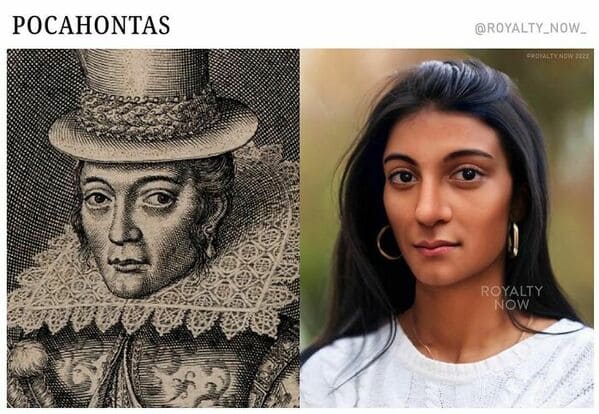
“Pocahontas is such a fascinating figure, I forgot how much I loved American history until revisiting this one. I didn’t have room to write a full historical summary here, so make sure you check out the new YouTube video on her (link in bio and story) for the full history and the animated image reveals.
This is the only contemporary image of a young Pocahontas (real name Matoaka – Pocahontas is a childhood nickname that stuck), commissioned by the Virginia Company after her visit to England with her husband John Rolfe in the early 1600s. Engravings aren’t typically the most flattering forms of art, and this one makes her look much older than her 20 years. But I do think her true likeness is definitely in there – you can still see her Native American features. Her features line up very distinctly with the descriptions of the Powhatan – that they have very strong cheekbones and jaws. They are also said to be naturally paler than other Native American groups, but they got very tan in the sun, with long straight black hair and black or brown eyes (H.C. Rountree)
For the 1600s version of Pocahontas, I researched how Powhatan women typically dress and how they adorn themselves. Like many Native American cultures, the Powhatans wear clothing, adornments, and tattoos that are based on age as well as gender. It’s hard to tell exactly what tattoos Pocahontas would have had in her own time, so I’ve used a tattoo pattern that is fairly common. Powhatan women wear deerskin dresses or aprons, and they are often decorated with shell beads. They wear necklaces and other jewelry to suit the occasion, and wear their hair long and free, or in a single long braid. I really, really love this version of Pocahontas.”
9.
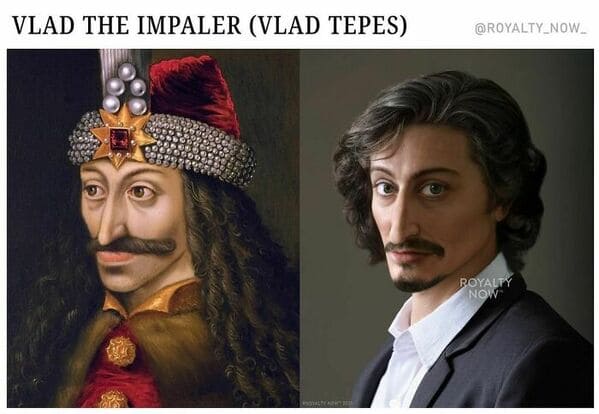
“Gotten a lot of requests for this one lately, thought it would be a great time of year to do Vlad Tepes, also known as Vlad the Impaler, the loose inspiration for the character of Dracula.
There is plenty more research you can do on Vlad’s life, but let’s talk about what he looked like! It’s important to note that there are no known contemporary images of Vlad Tepes. This portrait was painted in the 16th century, long after his death, by an unknown artist. It is perhaps thought to be a copy of a lost original. Some think that it was even painted by his enemies, as a cartoonish way to make him appear eviler. There is also a small painting of a man that is thought to be Vlad from the altar of the church of St. Maria, Vienna, painted in the year 1460 (see next slide).
We also only have one description of him, from Niccolò Modrussa, a papal legate. Niccolo describes Vlad as stocky, and strong, with a cold and terrible appearance. He had a strong aquiline nose, a thin face, with very large green eyes. He also had a strong neck, black curly hair, and wide shoulders.”
10.
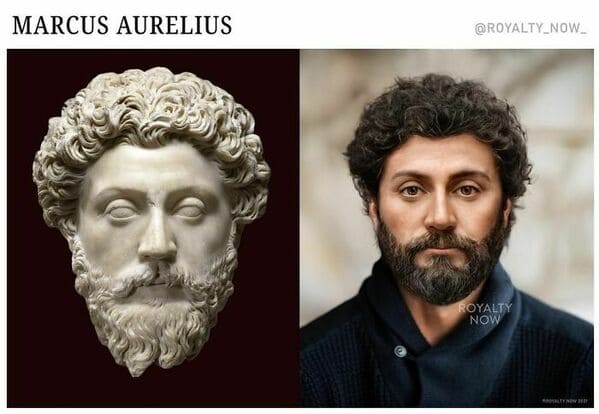
“The “Philosopher Emperor” – such a highly requested figure.
Marcus Aurelius was Emperor of Rome for 19 years from 161 – 180 AD. He ruled at nearly the height of the empire, with 70-80 million subjects, nearly one-fifth of the population of the earth at that time. He is famous for the Germanic Campaigns, as well as his book of stoic musings, called “Meditations,” which contains super pertinent bits of philosophy still used today. Unfortunately, Aurelius was the last of the “Five Good Emperors,” a string of good rulers that would eventually break thanks to Aurelius’ son Commodus. His reign is sometimes considered the tipping point between the glory days of the Empire and the beginning of the Fall of Rome.
Although we don’t know anything about his hair or eye color, we know that he is of Italian and Spanish heritage, so some guesswork definitely goes into this historical figure. Most other recreations I’ve seen give him tan skin and dark hair & eyes. Luckily there are many statues of Aurelius to work from, all sharing the same features.”
11.
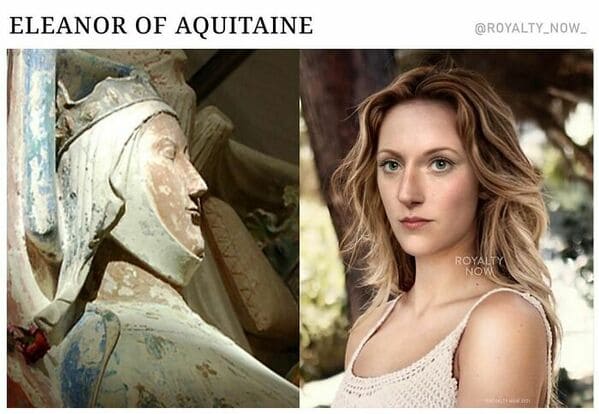
“Super excited to show another “artistic” version of a famous historical figure, especially since you all request her so often: Eleanor of Aquitaine.
Eleanor is the famous Medieval Queen of the 1100s who is remembered for her beauty, personality, and iron will. She was a truly incredible woman who desired independence, power, and the freedom to make her own choices. She is famously the Queen of King Henry II and the mother to King John and Richard the Lionheart.
Now in the case of Eleanor, we have no true images of her. She lived before the time of realistic portraits being painted. There are many romantic images of her that have been painted throughout the years (see next slides), but there’s really no way they can be accurate. The closest thing we have to accuracy for the nearly 1000-year-old queen is her tomb effigy from Fontevraud Abbey, which she may have had a hand in designing. It shows a tall, thin woman, with long and somewhat sharp features. Since we lack even any references to her hair or eye color, what I’ve done is create an artistic interpretation of her, based on several of these images of her.
Of course, it’s normal for contemporaries to laud the beauty of their queen, but it seems that in Eleanor’s case, she was truly the jewel of Aquitaine. She was described by a traveling musician as being “The embodiment of charm…with lovely eyes.” A German poet who briefly caught sight of the Queen writes: “Were all the world mine / from the sea to the Rhine / I’d give it all / if so be the Queen of England lay in my arms.””
12.
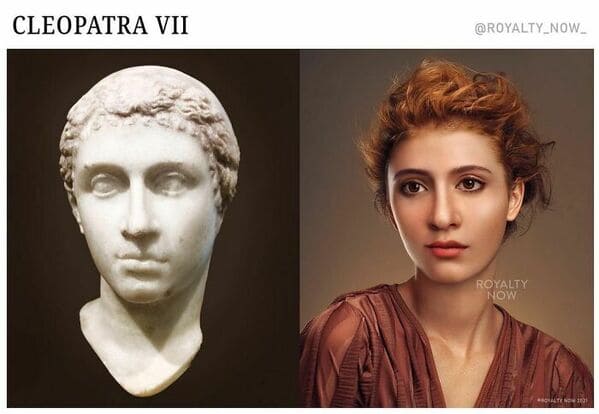
“Was Cleopatra a redhead? I have to admit I was fairly against this idea for a while, considering she was probably at least 75% Greek and Middle Eastern – my mind automatically went to dark hair. However, I wanted to do some additional research and present a red-headed version of her from the Berlin Bust, which I believe is a fairly accurate likeness of the Egyptian Queen.
The evidence for her being red-headed lies in a couple of images that aren’t confirmed but very likely could be Cleo. These are some frescoes from Pompeii and Herculaneum, as well as a cameo image that was made around her lifetime showing her with vivid red hair. Descriptions of the Fresco from Dr. Joann Fletcher: “Painted image from a villa at Herculaneum portraying a red-haired woman whose facial features, royal diadem and hairstyle adorned with fine pearl-studded hairpins suggest a posthumous portrait of Cleopatra VII.” So what do you guys think?”

